Abstract
Background
Children with mitochondrial disorders are frequently anesthetized for a wide range of operations. These disorders may interfere with the response to surgery and anesthesia. We examined anesthetic sensitivity to and respiratory effects of isoflurane in the Ndufs4 knockout (KO) mouse model. These mice exhibit an isolated mitochondrial complex I (CI) deficiency of the respiratory chain, and they also display clinical signs and symptoms resembling those of patients with mitochondrial CI disease.
Methods
We investigated seven Ndufs4−/− knockout (KO), five Ndufs4+/− heterozygous (HZ) and five Ndufs4+/+ wild type (WT) mice between 22 and 25 days and again between 31 and 34 days post-natal. Animals were placed inside an airtight box, breathing spontaneously while isoflurane was administered in increasing concentrations. Minimum alveolar concentration (MAC) was determined with the bracketing study design, using the response to electrical stimulation to the hind paw.
Results
MAC for isoflurane was significantly lower in KO mice than in HZ and WT mice: 0.81 % ± 0.01 vs 1.55 ± 0.05 % and 1.55 ± 0.13 %, respectively, at 22–25 days, and 0.65 ± 0.05 %, 1.65 ± 0.08 % and 1.68 ± 0.08 % at 31–34 days. The KO mice showed severe respiratory depression at lower isoflurane concentrations than the WT and HZ mice.
Conclusion
We observed an increased isoflurane anesthetic sensitivity and severe respiratory depression in the KO mice. The respiratory depression during anesthesia was strongly progressive with age. Since the pathophysiological consequences from complex I deficiency are mainly reflected in the central nervous system and our mouse model involves progressive encephalopathy, further investigation of isoflurane effects on brain mitochondrial function is warranted.


Similar content being viewed by others
References
Smeitink J, van den Heuvel L, DiMauro S. The genetics and pathology of oxidative phosphorylation. Nat Rev Genet. 2001;2:342–52.
Distelmaier F, Koopman WJ, van den Heuvel LP, Rodenburg RJ, Mayatepek E, Willems PH, Smeitink JA. Mitochondrial complex I deficiency: from organelle dysfunction to clinical disease. Brain. 2009;132:833–42.
Driessen JJ. Neuromuscular and mitochondrial disorders: what is relevant to the anaesthesiologist? Curr Opin Anaesthesiol. 2008;21:350–5.
Morgan PG, Hoppel CL, Sedensky MM. Mitochondrial defects and anesthetic sensitivity. Anesthesiology. 2002;96:1268–70.
Loeffen JL, Smeitink JA, Trijbels JM, Janssen AJ, Triepels RH, Sengers RC, van den Heuvel LP. Isolated complex I deficiency in children: clinical, biochemical and genetic aspects. Hum Mutat. 2000;15:123–34.
Koene S, Willems PH, Roestenberg P, Koopman WJ, Smeitink JA. Mouse models for nuclear DNA-encoded mitochondrial complex I deficiency. J Inherit Metab Dis. 2011;34:293–307.
Kayser EB, Suthammarak W, Morgan PG, Sedensky MM. Isoflurane selectively inhibits distal mitochondrial complex I in Caenorhabditis elegans. Anesth Analg. 2011;112:1321–9.
Allen GC. Bispectral index and mitochondrial myopathies. Anesthesiology. 2003;98:282 (Author reply 283).
Kruse SE, Watt WC, Marcinek DJ, Kapur RP, Schenkman KA, Palmiter RD. Mice with mitochondrial complex I deficiency develop a fatal encephalomyopathy. Cell Metab. 2008;7:312–20.
Budde SM, van den Heuvel LP, Smeets RJ, Skladal D, Mayr JA, Boelen C, Petruzzella V, Papa S, Smeitink JA. Clinical heterogeneity in patients with mutations in the NDUFS4 gene of mitochondrial complex I. J Inherit Metab Dis. 2003;26:813–5.
Koene S, Smeitink J. Metabolic manipulators: a well founded strategy to combat mitochondrial dysfunction. J Inherit Metab Dis. 2011;34:315–25.
Drexler B, Antkowiak B, Engin E, Rudolph U. Identification and characterization of anesthetic targets by mouse molecular genetics approaches. Can J Anaesth. 2011;58:178–90.
Eger EI 2nd, Raines DE, Shafer SL, Hemmings HC Jr, Sonner JM. Is a new paradigm needed to explain how inhaled anesthetics produce immobility? Anesth Analg. 2008;107:832–48.
Laster MJ, Liu J, Eger EI 2nd, Taheri S. Electrical stimulation as a substitute for the tail clamp in the determination of minimum alveolar concentration. Anesth Analg. 1993;76:1310–2.
Irifune M, Katayama S, Takarada T, Shimizu Y, Endo C, Takata T, Morita K, Dohi T, Sato T, Kawahara M. MK-801 enhances gabaculine-induced loss of the righting reflex in mice, but not immobility. Can J Anaesth. 2007;54:998–1005.
Sonner JM. Issues in the design and interpretation of minimum alveolar anesthetic concentration (MAC) studies. Anesth Analg. 2002;95:609–14 (Table of contents).
Quasha AL, Eger EI 2nd, Tinker JH. Determination and applications of MAC. Anesthesiology. 1980;53:315–34.
Quintana A, Morgan PG, Kruse SE, Palmiter RD, Sedensky MM. Altered anesthetic sensitivity of mice lacking Ndufs4, a subunit of mitochondrial complex I. PLoS One. 2012;7:e42904.
Driessen J, Willems S, Dercksen S, Giele J, van der Staak F, Smeitink J. Anesthesia-related morbidity and mortality after surgery for muscle biopsy in children with mitochondrial defects. Paediatr Anaesth. 2007;17:16–21.
Quintana A, Zanella S, Koch H, Kruse SE, Lee D, Ramirez JM, Palmiter RD. Fatal breathing dysfunction in a mouse model of Leigh syndrome. J Clin Invest. 2012;122:2359–68.
Humphrey JA, Sedensky MM, Morgan PG. Understanding anesthesia: making genetic sense of the absence of senses. Hum Mol Genet. 2002;11:1241–9.
Franks NP. General anaesthesia: from molecular targets to neuronal pathways of sleep and arousal. Nat Rev Neurosci. 2008;9:370–86.
Cohen PJ. Effect of anesthetics on mitochondrial function. Anesthesiology. 1973;39:153–64.
Hanley PJ, Ray J, Brandt U, Daut J. Halothane, isoflurane and sevoflurane inhibit NADH:ubiquinone oxidoreductase (complex I) of cardiac mitochondria. J Physiol. 2002;544:687–93.
Rottenberg H. Uncoupling of oxidative phosphorylation in rat liver mitochondria by general anesthetics. Proc Natl Acad Sci USA. 1983;80:3313–7.
Kohro S, Hogan QH, Nakae Y, Yamakage M, Bosnjak ZJ. Anesthetic effects on mitochondrial ATP-sensitive K channel. Anesthesiology. 2001;95:1435-340.
Roestenberg P, Manjeri GR, Valsecchi F, Smeitink JA, Willems PH, Koopman WJ. Pharmacological targeting of mitochondrial complex I deficiency: the cellular level and beyond. Mitochondrion. 2012;12:57–65.
Kayser EB, Sedensky MM, Morgan PG. The effects of complex I function and oxidative damage on lifespan and anesthetic sensitivity in Caenorhabditis elegans. Mech Ageing Dev. 2004;125:455–64.
Hirata N, Shim YH, Pravdic D, Lohr NL, Pratt PF Jr, Weihrauch D, Kersten JR, Warltier DC, Bosnjak ZJ, Bienengraeber M. Isoflurane differentially modulates mitochondrial reactive oxygen species production via forward versus reverse electron transport flow: implications for preconditioning. Anesthesiology. 2011;115:531–40.
Zhang J, Zhou W, Qiao H. Bioenergetic homeostasis decides neuroprotection or neurotoxicity induced by volatile anesthetics: a uniform mechanism of dual effects. Med Hypotheses. 2011;77:223–9.
Sanchez V, Feinstein SD, Lunardi N, Joksovic PM, Boscolo A, Todorovic SM, Jevtovic-Todorovic V. General anesthesia causes long-term impairment of mitochondrial morphogenesis and synaptic transmission in developing rat brain. Anesthesiology. 2011;115:992–1002.
Bains R, Moe MC, Larsen GA, Berg-Johnsen J, Vinje ML. Volatile anaesthetics depolarize neural mitochondria by inhibition of the electron transport chain. Acta Anaesthesiol Scand. 2006;50:572–933.
Berg-Johnsen J, Langmoen IA. The effect of isoflurane on excitatory synaptic transmission in the rat hippocampus. Acta Anaesthesiol Scand. 1992;36:350–5.
Acknowledgements
We are grateful for the help of Francien van de Pol, Ing., and Ilona van den Brink, Ing. (laboratory technicians, Department of Anesthesiology, Radboud University Medical Centre, Nijmegen, the Netherlands) for their technical assistance in performing the animal experiments. Funding was provided solely from institutional and/or departmental sources.
Conflict of interests
J Smeitink is CEO of Khondrion, a spin-off company of the Radboud University Medical Centre, Nijmegen, The Netherlands.
Author information
Authors and Affiliations
Corresponding author
Additional information
S. Roelofs and G. R. Manjeri contributed equally.
About this article
Cite this article
Roelofs, S., Manjeri, G.R., Willems, P.H. et al. Isoflurane anesthetic hypersensitivity and progressive respiratory depression in a mouse model with isolated mitochondrial complex I deficiency. J Anesth 28, 807–814 (2014). https://doi.org/10.1007/s00540-014-1791-0
Received:
Accepted:
Published:
Issue Date:
DOI: https://doi.org/10.1007/s00540-014-1791-0




